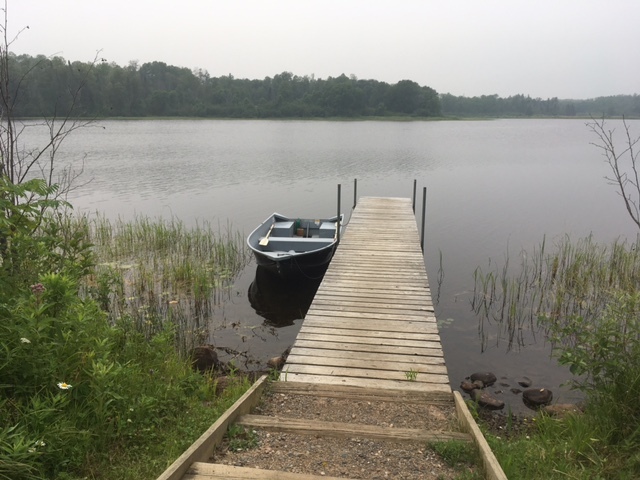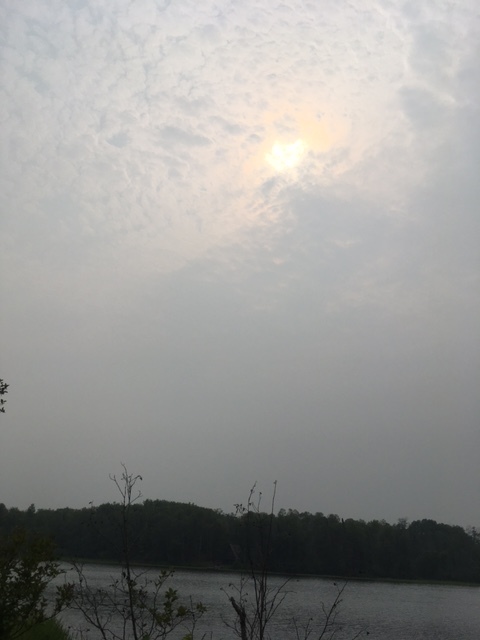Keep reading to find the Adventure down near the bottom. First we will muse on government work programs and their lasting effects on American parks.
I have to wonder what the Minnesota Park systems would have been like without the CCC and the WPA. I love these old buildings, built in the 30's and early 40's and lovingly preserved. Many state parks have Historic Lodges from that era, but only a few have CCC cabins like the one we stayed in. These are not the semi-civilized Camper Cabins that have been springing up lately in the Minnesota State Parks - these are the real thing - cabins WITH INDOOR PLUMBING. There are 5 of them at the shady end of the Riverview Campground, this 3-plex and a nearby duplex. These are the doorways to adjacent cabins C and D. Cabin E has its own more private entrance off to the right. But the shared entry to Cabin D turned out to be a lifesaver for us (keep reading...)

Inside, the cabins are all pine everywhere: floors, ceiling, walls, and furniture. There's a reasonably comfortable double bed, a sturdy pine table and chairs, and even a closet with suitcase rack. You have to bring your own bedding and towels, but most everything else is provided. Except a fan. The windows open for ventilation, but without a fan to circulate the air it can get hot and stuffy. And like every other hotel room in the world, there is a nice sized closet with only 4 hangers. So if you stay in one of these, bring a fan and hangers. The less said about the window coverings the better. Let's just say that, wonderful as these little cabins are, there is room for improvement here.

But here's where these cabins outshine every other State Park in the state except some of the Itasca campgrounds (and who can compete with Itasca, the jewel of the park system?). A half bath and a FULL KITCHEN, stocked with pots and pans and dinnerware and even a coffeepot and toaster. This is living. $95/night. For only $70 for the upgrade, why would anyone sleep in a tent?

And after indoor plumbing, there's location location location. In this case, that is way off on the shady side of a classic oak savanna with at least an acre or two of grass separating the cabins from the hoi poloi in the not so shady side of the campground. Here's our private picnic table with Cabins A/B in the background. Cabin A is the one I'd choose next time, having only one immediate neighbor and more shade. But they are all great.

The cabins do have one more weak point, however, at least if you are prone to lose your focus now and then. The cheap little spring locks lock behind you like a hotel room door, and there is only one key. It was my job to keep track of the key, so each time I reenabled the door lock I recited to myself, "I am locking the door now. Is the key in my pocket? Yes it is. Okay, then." Until the very last night, when ![[personal profile]](https://www.dreamwidth.org/img/silk/identity/user.png) spiderplanet stopped by to see what the cabin looked like. Distracted by having company, I didn't do my little ritual and... you guessed it. Locked myself out. By the time I realized that we were outside and the key was safely hanging on a hook inside, it was 10:30 pm and the three RV couples had gone off to the Horse Camp a million miles away on the other side of this huge park, and there we were, alone in the dark. FORTUNATELY I had talked
spiderplanet stopped by to see what the cabin looked like. Distracted by having company, I didn't do my little ritual and... you guessed it. Locked myself out. By the time I realized that we were outside and the key was safely hanging on a hook inside, it was 10:30 pm and the three RV couples had gone off to the Horse Camp a million miles away on the other side of this huge park, and there we were, alone in the dark. FORTUNATELY I had talked ![[personal profile]](https://www.dreamwidth.org/img/silk/identity/user.png) arkuat and
arkuat and ![[personal profile]](https://www.dreamwidth.org/img/silk/identity/user.png) pameladean into renting Cabin D, and they were still awake. So we routed them out, not sure what they could do that we couldn't, but just feeling like we had no chance without friends. My only real plan was to see if there was an emergency number posted inside the cabins. And yes, there was such a number! And miraculously, my phone was still eking out one bar of service, so I called it. Only to find that the number had been disconnected. Not just nobody answering the supposedly 24 hour number, mind you - the number was gone. Thanks a lot, underfunded Park Service.
pameladean into renting Cabin D, and they were still awake. So we routed them out, not sure what they could do that we couldn't, but just feeling like we had no chance without friends. My only real plan was to see if there was an emergency number posted inside the cabins. And yes, there was such a number! And miraculously, my phone was still eking out one bar of service, so I called it. Only to find that the number had been disconnected. Not just nobody answering the supposedly 24 hour number, mind you - the number was gone. Thanks a lot, underfunded Park Service.
Fortunately, these little cabins are not the most secure structures in the world, and it turned out to be pretty easy to break in through the windows. The outer glass windows were mostly open (and even if they weren't the latches don't really work on them, so...). The inner screens do have latches, but my inattentiveness had fortunately extended to failing to latch one of the screens securely, so we didn't have to cut the screen. And since we had neighbors with furniture we didn't have to haul one of the incredibly heavy picnic tables over to the window. The indefatigable ![[personal profile]](https://www.dreamwidth.org/img/silk/identity/user.png) arkuat volunteered not only a chair but his own services as a burglar to climb up and dive through the window, and voila! We were saved. All thanks to the brave
arkuat volunteered not only a chair but his own services as a burglar to climb up and dive through the window, and voila! We were saved. All thanks to the brave ![[personal profile]](https://www.dreamwidth.org/img/silk/identity/user.png) arkuat !
arkuat !
Okay, on to the last building - the Historic Lodge - also built by the CCC out of native limestone and huge hunks of pine. Even the original tables and chairs are still in use, showing no signs of ever wearing out. It's a little hard to see in this picture, but the legs of these pieces of furniture are made of the same giant tree trunks as the overhead beams. This fine building has lights and restrooms and is open round the clock. We met there for gaming on Saturday.


























